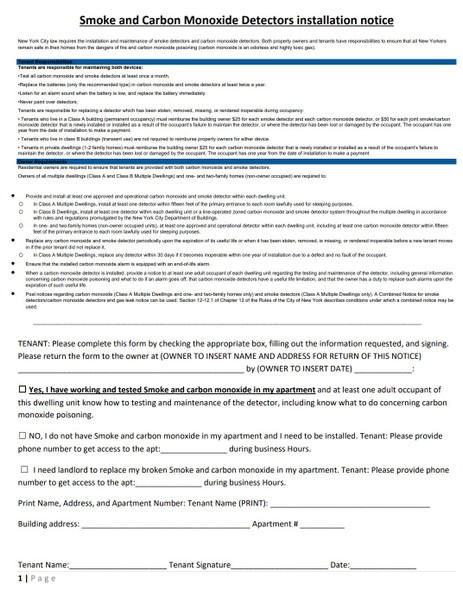- Home
- ** FREE DOWNLOADS FDNY **
- Checklist for Installing Natural Gas Detectors requirments per LL157 (pdf file)
hpdsigns.nyc
Checklist for Installing Natural Gas Detectors requirments per LL157 (pdf file)
- SKU:
- Natural Gas Detectors requirments per LL157 NYS AND HPD NYC
- UPC:
- MPN:
- Natural Gas Detectors
Description
Checklist for Installing Natural Gas Detectors
DOWNLOAD FOR FREE OUR PDF FILE
New York State Gas Detector Requirements in Residential Buildings
Overview
In an effort to enhance safety and prevent potential gas-related incidents, New York State has implemented regulations mandating the installation of gas detectors in residential buildings. These requirements, outlined in the state's Local Law 157 (LL157), aim to provide early warning of gas leaks, thereby protecting residents from the dangers of natural gas and carbon monoxide exposure.
Requirements for Gas Detectors in Residential Buildings
Under New York State regulations, all residential buildings must have gas detectors installed. The specific requirements include:
- Types of Detectors: Buildings must be equipped with natural gas detectors and carbon monoxide detectors.
- Location of Detectors:
- In Dwelling Units: Detectors must be installed within each dwelling unit. They should be placed in locations where gas leaks are most likely to occur, such as near gas appliances (e.g., stoves, ovens, furnaces) and in rooms where people sleep to ensure they are alerted even during nighttime.
- Common Areas: In multi-unit residential buildings, gas detectors should also be installed in common areas such as hallways, basements, and mechanical rooms where gas lines or appliances are present.
- Installation and Maintenance: The responsibility for installation and maintenance of gas detectors falls on building owners. Detectors must be installed according to the manufacturer’s instructions and must be regularly tested and maintained to ensure they are in proper working condition. Owners must also replace detectors at the end of their useful life, as specified by the manufacturer.
Summary of New York State Local Law 157 (LL157)
Local Law 157, enacted by the New York City Council, mandates the installation of natural gas detectors in all residential buildings. The law was passed in response to several gas-related incidents that highlighted the need for improved safety measures in residential properties.
Key provisions of LL157 include:
- Scope of the Law: LL157 applies to all residential buildings within New York City, encompassing both single-family homes and multi-unit dwellings.
- Implementation Timeline: The law stipulates specific deadlines by which gas detectors must be installed. Building owners were given a grace period to comply with the new requirements, with final deadlines varying based on building type and size.
- Penalties for Non-Compliance: Building owners who fail to comply with LL157 face penalties, including fines. The law is enforced by the New York City Department of Housing Preservation and Development (HPD) and the New York City Fire Department (FDNY).
- Public Awareness and Education: LL157 includes provisions for public education campaigns to ensure that residents and building owners are aware of the new requirements and understand the importance of gas detectors for safety.
Importance of Compliance
Compliance with New York State’s gas detector requirements and LL157 is crucial for the safety and well-being of residents. Gas leaks can lead to catastrophic incidents, including explosions and carbon monoxide poisoning, which can be fatal. Early detection through properly installed and maintained gas detectors can prevent these tragedies and save lives.
Building owners and residents alike should familiarize themselves with the specific requirements and take proactive steps to ensure their properties are equipped with functioning gas detectors. Regular maintenance and testing are essential to ensure that these life-saving devices remain operational and effective in providing early warnings of potential gas leaks.
Conclusion
The New York State gas detector requirements, along with Local Law 157, represent a significant step forward in enhancing residential safety. By mandating the installation of natural gas and carbon monoxide detectors, the state aims to protect residents from the dangers associated with gas leaks. Building owners must comply with these regulations and ensure their properties are equipped with the necessary detectors, thereby contributing to a safer living environment for all.
DISCLAIMER these codes may not be the most recent version. The State / federal or other regulation department may have more current or accurate information. We make no warranties or guarantees about the accuracy, completeness, or adequacy of the information contained on this site or the information linked to on the state site. Please check official sources. The requirements for detector are determined by intended use and by applicable regulation. The BUYER is responsible for determining the appropriate detector needed. WE make no warranty or representation of suitability of a detector to any code or for any specific application. IT IS THE CUSTOMER'S RESPONSIBILITY TO ENSURE THAT THE DETECTORS THE CUSTOMER ORDERS ARE IN COMPLIANCE WITH ALL STATE, FEDERAL, LOCAL, AND MUNICIPAL LAWS. Please review terms and conditions prior to purchase. For more information about what is required, see the laws that are referenced and the rules applicable to your city and state. This page is for informational purposes only and is not intended as legal advice, professional advice or a statement of law. You may wish to consult with an attorney.
Related Products


Natural Gas Detectors LL157 (PDF)
hpdsigns.nyc


What type of Natural Gas Detectors shell i install per LL157 (word Doc file)
hpdsigns.nyc

Where to Install Natural Gas Detectors in an Apartment (pdf file)
hpdsigns.nyc

Required Notice to provide to tenants checkList (pdf file)
hpdsigns.nyc


Smoke and Carbon monoxide detector installation notice (pdf file)
hpdsigns.nyc

Natural Gas Safety and the Importance of Leak Detectors: Guidance from FDNY (pdf file)
hpdsigns.nyc







